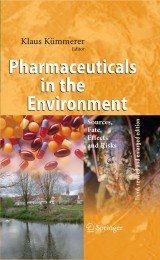Details

Pharmaceuticals in the Environment
Sources, Fate, Effects and Risks3rd enlarged ed. 2008
|
213,99 € |
|
| Verlag: | Springer |
| Format: | |
| Veröffentl.: | 10.10.2008 |
| ISBN/EAN: | 9783540746645 |
| Sprache: | englisch |
| Anzahl Seiten: | 522 |
Dieses eBook enthält ein Wasserzeichen.
Beschreibungen
When the first green wave appeared in the mid and late 1960s, it was considered a f- sible task to solve pollution problems. The visible problems were mostly limited to point sources, and a comprehensive “end of the pipe technology” (= environmental technology) was available. It was even seriously discussed in the US that what was called “zero d- charge” could be attained by 1985. It became clear in the early 1970s that zero discharge would be too expensive, and that we should also rely on the self purification ability of ecosystems. That called for the development of environmental and ecological models to assess the self purifi- tion capacity of ecosystems and to set up emission standards, considering the re- tionship between impacts and effects in the ecosystems. This idea is illustrated in Fig. 0.1. A model is used to relate an emission to its effect on the ecosystem and its components. The relationship is applied to select a good solution to environmental problems by application of environmental technology.
General Aspects.- Pharmaceuticals in the Environment – A Brief Summary.- Special Characteristics of Pharmaceuticals Related to Environmental Fate.- Sources, Occurrence and Fate.- Drug Production Facilities – An Overlooked Discharge Source for Pharmaceuticals to the Environment.- Substance Flows Associated with Medical Care – Significance of Different Sources.- Pharmaceutical Residues in Northern European Environments: Consequences and Perspectives.- Antibiotics in the Environment.- Veterinary Antibiotics in Dust: Sources, Environmental Concentrations, and Possible Health Hazards.- Fate of Veterinary Medicines Applied to Soils.- Pharmaceuticals as Environmental Contaminants: Modeling Distribution and Fate.- Environmental Exposure Modeling: Application of PhATE™ and Great-ER to Human Pharmaceuticals in the Environment.- Exposure Assessment Methods for Veterinary and Human-Use Medicines in the Environment: PEC vs. MEC Comparisons.- Effects.- Effects of Pharmaceuticals on Aquatic Organisms.- Another Example of Effects of Pharmaceuticals on Aquatic Invertebrates: Fluoxetine and Ciprofloxacin.- Effects of Antibiotics and Virustatics in the Environment.- Realizing the Potential Benefits of Small Animal Models for the Aquatic Hazard Assessment of Human Pharmaceuticals: A Conceptual Approach.- On the Ecotoxicology of Pharmaceutical Mixtures.- Chronic Mixture Toxicity of Pharmaceuticals to Daphnia – The Example of Nonsteroidal Anti-Inflammatory Drugs.- The Ecotoxicological Effects of Pharmaceuticals (Antibiotics and Antiparasiticides) in the Terrestrial Environment – a Review.- Odorants – Potent Substances at Minor Concentrations: The Ecological Role of Infochemicals.- Risk Assessment.- European Developments in the Environmental Risk Assessment of Pharmaceuticals.-The State and the Future Development/Perspective of Environmental Risk Assessment of Medicinal Products for Human Use: Aspects of Its Regulations in Japan.- Deterministic and Probabilistic Environmental Risk Assessment for Diazepam.- Comparison of Prospective and Retrospective Environmental Risk Assessments of Human Pharmaceuticals.- Methodological Aspects Concerning the Environmental Risk Assessment for Medicinal Products; Research Challenges.- Risk Management.- Strategies for Reducing the Input of Pharmaceuticals into the Environment.- Cost Action 636 Xenobiotics in the Urban Water Cycle – A Network for Collaboration within Europe.- Removal of Pharmaceutical Residues from Contaminated Raw Water Sources by Membrane Filtration.- Photooxidation as Advanced Oxidation Treatment of Hospital Effluents.- Pharmaceuticals and Environment: Role of Community Pharmacies.- Mitigation of the Pharmaceutical Outlet into the Environment – Experiences from Sweden.- Pharmaceutical Waste.
Addresses the most important issues in the field of pharmaceuticals in the environment for the near future Typical examples and abundant data are presented
<P>The study of pharmaceuticals in the environment is a relatively new area of research. This edition addresses the most important issues in the field for the near future. Following the resounding success of the first two editions, this new edition has been brought up-to-date and greatly extended. It includes the status of research on soil, paying particular attention to field studies in terrestrial and aquatic environments as well as new substance categories such as tetracylines and chinolones and the latest results concerning contamination of the environment and risk reduction. In line with the newest developments worldwide there are now many more contributions from international authors. This volume also caters for the new requirements confronting European and American researchers since publication of the first edition. This book provides the reader with a well-founded overview which even specialists will appreciate.</P>

















